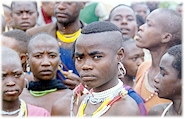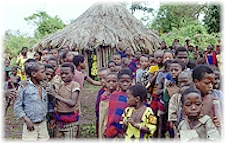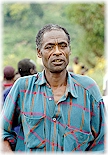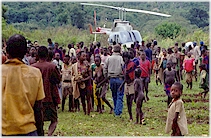 The third week of January 1996, John Bechtel was stuck in a snow storm in New York City thus scrubbing a helicopter expedition for him and Stewart Dow of the DeMoss Foundation. I decided that the mission was important enough to go without them. Arnell Motz, SIM Director for Canada, now serving six months teaching at ETC and preaching at IEC, and a friend Andrew Barnes from Food for the Hungry and I flew from Addis to Waka, due west from Soddo. We were flying with Helimission in their Jet Ranger with Dan Spencer and Tony Piercy as pilots. We picked up Ato Eyob, the KHC leader of the Dawaro district, and a former student of my Dad in Walaita back in the mid-sixties. He has a cast in one of his eyes. Anyhow, we headed to the TARRA people (The “T” is exploded) and landed in a clearing called Oshka-Dencha. (New name is Oshka-tera-go-na)
The third week of January 1996, John Bechtel was stuck in a snow storm in New York City thus scrubbing a helicopter expedition for him and Stewart Dow of the DeMoss Foundation. I decided that the mission was important enough to go without them. Arnell Motz, SIM Director for Canada, now serving six months teaching at ETC and preaching at IEC, and a friend Andrew Barnes from Food for the Hungry and I flew from Addis to Waka, due west from Soddo. We were flying with Helimission in their Jet Ranger with Dan Spencer and Tony Piercy as pilots. We picked up Ato Eyob, the KHC leader of the Dawaro district, and a former student of my Dad in Walaita back in the mid-sixties. He has a cast in one of his eyes. Anyhow, we headed to the TARRA people (The “T” is exploded) and landed in a clearing called Oshka-Dencha. (New name is Oshka-tera-go-na)
The Tarra people are located in an isolated tropical rain forest just between the Omo River and the Dencheyo River in the Konta area of Northern Omo in southern Ethiopia. Some Tarra people also live on the Kaffa side of the Dencheyo River. Amaya is the wereda capital. It is a three day walk from Oshka Dencha. At the time of this first visit I knew of no one who had heard of them, not even Wycliffe. I have since confirmed that Australian, SIM missionary, Dick McClellan, twenty-three years ago trekked up from Bodi land by mule for an over night.
 They are a stone age like, semi-nomadic group that have moved to the highlands and have learned to do some farming. Under the canopy of the forest they have begun to plant corn, coffee and indigenous spices. A man pokes a hole in the ground and the woman follows with a baby on back putting the corn seed in the hole and then stomping on it with her heal. They are big into honey! They eat honey three times a day. They dip bananas or a flat bread made out of sorghum. They smelt their own iron to make their weapons and digging instruments. Very crude but very fascinating.
They are a stone age like, semi-nomadic group that have moved to the highlands and have learned to do some farming. Under the canopy of the forest they have begun to plant corn, coffee and indigenous spices. A man pokes a hole in the ground and the woman follows with a baby on back putting the corn seed in the hole and then stomping on it with her heal. They are big into honey! They eat honey three times a day. They dip bananas or a flat bread made out of sorghum. They smelt their own iron to make their weapons and digging instruments. Very crude but very fascinating.
They have very few cattle, and as a result, they do not know how to plow. One reason they do not have many cattle is that their greatest enemy, the fierce and feared nomadic Bodi from the lowland across the Omo River, have stolen the few they have had. The Tarra live in constant fear that the Bodi will make raids and kill their own.
The government has made no entrance to these people in the way of clinics or schools or administration. In fact the Tarra have their own king (“bal-abat”). They said that the population is between ten and twenty thousand. Virtually all except for some very old senior citizen had never seen white folk before. I felt like I was stepping back in time several thousand years.
 A year ago a Kale Heywet Church (SIM related churches) evangelist (national cross cultural missionary) from Walaita named Bekele Minota had a dream or a vision from the Lord. . He was to walk until he could walk no further . Well he did just that. He hiked ten days south from Waka until he could go no further because he couldn’t cross the junction of the two rivers. (The Omo and the Dencheyo rivers) He thought he was at the end of the world. And I think he was! He built a shelter and began to learn their own language (Tarraenia) and minister to the Tarra. He gave salt to a family to give him protection. This is called “jarra”.
A year ago a Kale Heywet Church (SIM related churches) evangelist (national cross cultural missionary) from Walaita named Bekele Minota had a dream or a vision from the Lord. . He was to walk until he could walk no further . Well he did just that. He hiked ten days south from Waka until he could go no further because he couldn’t cross the junction of the two rivers. (The Omo and the Dencheyo rivers) He thought he was at the end of the world. And I think he was! He built a shelter and began to learn their own language (Tarraenia) and minister to the Tarra. He gave salt to a family to give him protection. This is called “jarra”.
They live in desperate fear of retribution of the evil spirits. The Tarra people sleep with a covering over their heads at night usually made of crushed bark to protect the evil spirits from entering their noses or their ears. Many have the Tarra “clappers” which are two pieces of thick, dried hide of the Cape Buffalo. When one reaches the intersection of two paths he lifts the clappers toward the sun or the moon and claps the clappers. They believe they receive a message from the spirits as to which foot path to take.
Bekele’s greatest enemy was not the people, but three witchdoctors who wished he were dead and made attempts to kill him. In answer to Bekele prayers, within a year all three witch doctors had died. Two had died of disease and a lightning bolt out of the heavens struck the house of the third burning it and all the contents to the ground. This witchdoctor fled in fear and latter died. Sounds like Elijah days!
 Bekele, with a demonstrative love for the people and great zeal in the power of the Spirit of God began to share his faith in Jesus Christ. In time, Gezehein, the son of the king and his wife, came to a Christ. They were the first Christians in Tarra. When Bekele was out of the area during the rainy season, a Tarra woman became very ill. The witchdoctor could not help her. One new believer said ” Let us pray to the god of Bekele and pray the way he does.” They prayed for the first time in their lives and the woman was miraculously healed. As a result of this many believed. There are now more than sixty believers meeting in a little grass thatched church on the cleared hill of Oska Dencha.
Bekele, with a demonstrative love for the people and great zeal in the power of the Spirit of God began to share his faith in Jesus Christ. In time, Gezehein, the son of the king and his wife, came to a Christ. They were the first Christians in Tarra. When Bekele was out of the area during the rainy season, a Tarra woman became very ill. The witchdoctor could not help her. One new believer said ” Let us pray to the god of Bekele and pray the way he does.” They prayed for the first time in their lives and the woman was miraculously healed. As a result of this many believed. There are now more than sixty believers meeting in a little grass thatched church on the cleared hill of Oska Dencha.
Of course the Tarra people do not speak any Amharic, the national language of Ethiopia, and the language that the Bible is translated into. Bekele’s desire was that the children learn the Word of God. To do this he would have to teach the Tarra to learn Amharic. He started teaching “fee-del”, the Amharic alphabet. The school began to grow to where there are now about seventy students. Though many were reluctant to come at first, has gained great respect from the students and from the parents too. ( Bekele has now arranged for two Christian teachers, Asefa and Tamirat from Jimma ,to teach in the school.)
When it comes to fashion, the Tarra people are basically naked except for the ones that have believed. Bekele has clothed them. The older women wear leaves around their waists. The young girls that are eligible for marriage wear chains around the waist to cover themselves, with empty ammunition shells tied to the chains for decoration. Colorful beads around the neck and some tied to strands of hair is the fashion. Many men and women wear hoop earrings made our of the iron they have smelted. Also common are bracelets that have been made by melting coins from Emperor Haile Salassie’s days that are no longer in circulation. They are very heavy and have creative designs etched in them.
Marriage without a wedding is the tradition of the Tarra. Parents do check for background and family to help determine a spouse. For most young girls the brideprice is three cows to be paid to the bride’s father and thirty birr to be paid directly to the bride’s mother. Remember cows are quite scarce in this society and therefore quite precious. The couple secretly determine a date. By the way, there are no calendars in Tarra. The day the moon disappears they hang a basket and put rocks in it to keep track of time and the number of days that have passed. After so many stones are put into the basket, in sly fashion the couple disappears into the forest. After some time in the woods, they build a hut near the husband’s father house. Usually it does not end with one wife. It is a polygamous society with most having more than two wives.
When one dies, the relatives kill an ox or a cow not by bleeding it first, but by lifting a big boulder and heaving it hitting the ox in the head. Latter blood is poured into a gourd. Each relative dips their fingers into the blood and begins to paint the corps. The house of the dead person is burned to the ground with the contents, fearing that the evil spirit that was responsible for the death was in the house. They do build a coffin or dig a grave and bury their dead as most do in Ethiopia. They simply find a cave to put the corpse in it.
Greeting close relatives is very humorous. When a relative from some distance away visits a home of another relative. The home owner get on his knees and bows down. The visiting relative lifts his leg and swings it around and around the head of the relative in the prostrate position. What a greeting!
I share all of this with you, first so you can pray for them. I feel deeply burdened as never before for these “hidden” people. Because of their isolation with no access by road, we will initially have to use a helicopter to go in and to do more survey work. I also sense an urgency that SIM and KHC need to move ahead swiftly to penetrate the Tarra with the gospel. I will be trying to facilitate that at this end.
My Second Trip into the Tarra People
April 8-9, 1996
 I helicoptered in to Tarra again last week to encourage the fifty or sixty believers. Since I was in there the first time in January, the witchdoctors have been persecuting and taunting the new Christians saying that the white man will never come again with the message from the book and that they should return to Satan. Bekele, the Walaita evangelis,t had not been present for many weeks. Some had presumed he was killed. One of the new believers, Jango Rangelow, was really low and distressed and proceeded into the grass-thatched hut which is the church to pray. He was on his knees in prayer crying out to God for three consecutive days and nights seeking His face for relief from the evil pursuit of the witchdoctors. Three days after his prayer, we blew in out of the sky in the helicopter to rally and encouraged the “troops”. It is like the story of Elijah. Never were we received as we were that day. It was a day of great jubilation and praise to God.
I helicoptered in to Tarra again last week to encourage the fifty or sixty believers. Since I was in there the first time in January, the witchdoctors have been persecuting and taunting the new Christians saying that the white man will never come again with the message from the book and that they should return to Satan. Bekele, the Walaita evangelis,t had not been present for many weeks. Some had presumed he was killed. One of the new believers, Jango Rangelow, was really low and distressed and proceeded into the grass-thatched hut which is the church to pray. He was on his knees in prayer crying out to God for three consecutive days and nights seeking His face for relief from the evil pursuit of the witchdoctors. Three days after his prayer, we blew in out of the sky in the helicopter to rally and encouraged the “troops”. It is like the story of Elijah. Never were we received as we were that day. It was a day of great jubilation and praise to God.
Another neat thing about this visit was that my boys, Drew, Ryan and Kyle were able to be with me to witness this great testimony of God’s power,timing, and answer to prayer. None of us will ever forget sitting together in that little hut listening to this testimony.
Jango, having spoken of God’s answered prayer began to tell his own story to all of us packed into the hut My boys with the rest of us listened in wrapped attention. Before Jango received Christ he had murdered his father. His father, stoned drunk, pursued him with a AK 47 assault weapon. Jango taunted his Dad with a spear. With the spear still in hand, Jango pierced the flesh of his father’s chest penetrating the heart. His dad died instantly. After nine months of prison in Jimma, Jango was released. Upon returning home he had to pay the blood-price of two cows to the local witchdoctor. He also had to pay his uncle five cows and a son. Since he had no sons of his own, he had to give his uncle the son of one of his brothers. His oldest and youngest brothers were witchdoctors. Each of them were killed by the Bodi nomads. Jango is raising their six children. It was then that Bekele came and told him that Christ had shed his blood to free him from sin and Satan’s domination. Bekele said “Repent and believe and receive Jesus Christ”. And Jango did just that.
From now until August I have three trips planned into the Tarra people. I really need your prayer as it relates to these trips. I will be taking in Kale Heywet church ( SIM related national churches) leaders from each level of administration, from top to bottom, to see first hand the need of reaching the Tarra. The key is, the church must catch the vision of reaching the lost Tarra. From the very beginning we, SIM, must pray, plan and strategize together with KHC under the Lord’s leadership to reach the Tarra with the gospel. Join in this great adventure of faith. Begin by praying!
Dig-ga, onsa diga! (Hi and good-bye in the Tarra language)
The Lord is not willing that any should perish but that all should come to repentance and faith in Him.
